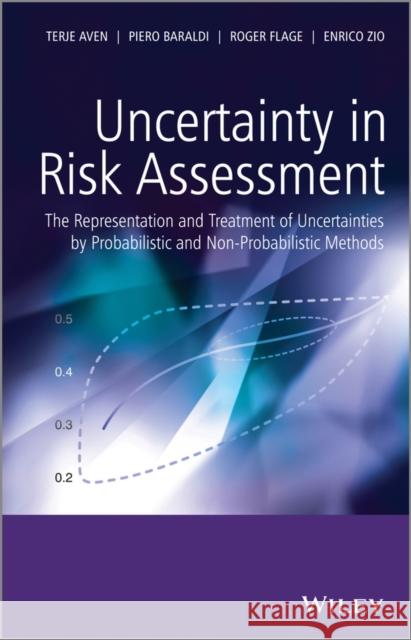Uncertainty in Risk Assessment: The Representation and Treatment of Uncertainties by Probabilistic and Non-Probabilistic Methods » książka



Uncertainty in Risk Assessment: The Representation and Treatment of Uncertainties by Probabilistic and Non-Probabilistic Methods
ISBN-13: 9781118489581 / Angielski / Twarda / 2014 / 200 str.
Uncertainty in Risk Assessment: The Representation and Treatment of Uncertainties by Probabilistic and Non-Probabilistic Methods
ISBN-13: 9781118489581 / Angielski / Twarda / 2014 / 200 str.
(netto: 344,82 VAT: 5%)
Najniższa cena z 30 dni: 360,57
ok. 30 dni roboczych
Bez gwarancji dostawy przed świętami
Darmowa dostawa!
This book addresses an important and current problem with competing solutions.
Wydanie ilustrowane
Therefore, I would recommend this book to a broad audience, from advanced undergraduates, to specialists, including probability theoreticians. (Computing Reviews, 16 July 2014)
Preface ix
PART I INTRODUCTION 1
1 Introduction 3
1.1 Risk 4
1.1.1 The concept of risk 4
1.1.2 Describing/measuring risk 6
1.1.3 Examples 6
1.2 Probabilistic risk assessment 8
1.3 Use of risk assessment: The risk management and decision–making context 11
1.4 Treatment of uncertainties in risk assessments 13
1.5 Challenges: Discussion 15
1.5.1 Examples 16
1.5.2 Alternatives to the probability–based approaches to risk and uncertainty assessment 17
1.5.3 The way ahead 19
References Part I 21
PART II METHODS 27
2 Probabilistic approaches for treating uncertainty 29
2.1 Classical probabilities 30
2.2 Frequentist probabilities 31
2.3 Subjective probabilities 35
2.3.1 Betting interpretation 36
2.3.2 Reference to a standard for uncertainty 36
2.4 The Bayesian subjective probability framework 37
2.5 Logical probabilities 39
3 Imprecise probabilities for treating uncertainty 41
4 Possibility theory for treating uncertainty 45
4.1 Basics of possibility theory 45
4.2 Approaches for constructing possibility distributions 49
4.2.1 Building possibility distributions from nested probability intervals 49
4.2.2 Justification for using the triangular possibility distribution 51
4.2.3 Building possibility distributions using Chebyshev s inequality 52
5 Evidence theory for treating uncertainty 53
6 Methods of uncertainty propagation 59
6.1 Level 1 uncertainty propagation setting 61
6.1.1 Level 1 purely probabilistic framework 62
6.1.2 Level 1 purely possibilistic framework 64
6.1.3 Level 1 hybrid probabilistic possibilistic framework 67
6.2 Level 2 uncertainty propagation setting 71
6.2.1 Level 2 purely probabilistic framework 73
6.2.2 Level 2 hybrid probabilistic evidence theory framework 75
7 Discussion 79
7.1 Probabilistic analysis 80
7.2 Lower and upper probabilities 82
7.3 Non–probabilistic representations with interpretations other than lower and upper probabilities 84
7.4 Hybrid representations of uncertainty 85
7.5 Semi–quantitative approaches 87
References Part II 93
PART III PRACTICAL APPLICATIONS 99
8 Uncertainty representation and propagation in structural reliability analysis 101
8.1 Structural reliability analysis 101
8.1.1 A model of crack propagation under cyclic fatigue 101
8.2 Case study 102
8.3 Uncertainty representation 104
8.4 Uncertainty propagation 105
8.5 Results 107
8.6 Comparison to a purely probabilistic method 107
9 Uncertainty representation and propagation in maintenance performance assessment 111
9.1 Maintenance performance assessment 111
9.2 Case study 113
9.3 Uncertainty representation 116
9.4 Uncertainty propagation 118
9.4.1 Maintenance performance assessment in the case of no epistemic uncertainty on the parameters 118
9.4.2 Application of the hybrid probabilistic theory of evidence uncertainty propagation method 122
9.5 Results 123
10 Uncertainty representation and propagation in event tree analysis 127
10.1 Event tree analysis 127
10.2 Case study 128
10.3 Uncertainty representation 134
10.4 Uncertainty propagation 135
10.5 Results 137
10.6 Comparison of the results to those obtained by using other uncertainty representation and propagation methods 138
10.6.1 Purely probabilistic representation and propagation of the uncertainty 138
10.6.2 Purely possibilistic representation and propagation of the uncertainty 138
10.7 Result comparison 141
10.7.1 Comparison of results 141
10.7.2 Comparison of the results for the probability of occurrence of a severe consequence accident 145
11 Uncertainty representation and propagation in the evaluation of the consequences of industrial activity 147
11.1 Evaluation of the consequences of undesirable events 147
11.2 Case study 148
11.3 Uncertainty representation 150
11.4 Uncertainty propagation 152
11.5 Results 152
11.6 Comparison of the results to those obtained using a purely probabilistic approach 153
12 Uncertainty representation and propagation in the risk assessment of a process plant 155
12.1 Introduction 155
12.2 Case description 155
12.3 The textbook Bayesian approach (level 2 analysis) 156
12.4 An alternative approach based on subjective probabilities (level 1 analysis) 159
References Part III 163
PART IV CONCLUSIONS 167
13 Conclusions 169
References Part IV 173
Appendix A Operative procedures for the methods of uncertainty propagation 175
A.1 Level 1 hybrid probabilistic possibilistic framework 175
A.2 Level 2 purely probabilistic framework 176
Appendix B Possibility probability transformation 179
Reference 181
Index 183
Terje Aven, University of Stavanger, Norway
Piero Baraldi, Politecnico di Milano, Italy
Roger Flage, University of Stavanger, Norway
Enrico Zio, Politecnico di Milano, Italy
Explores methods for the representation and treatment of uncertainty in risk assessment
In providing guidance for practical decision–making situations concerning high–consequence technologies (e.g., nuclear, oil and gas, transport, etc.), the theories and methods studied in Uncertainty in Risk Assessment have wide–ranging applications from engineering and medicine to environmental impacts and natural disasters, security, and financial risk management. The main focus, however, is on engineering applications.
While requiring some fundamental background in risk assessment, as well as a basic knowledge of probability theory and statistics, Uncertainty in Risk Assessment can be read profitably by a broad audience of professionals in the field, including researchers and graduate students on courses within risk analysis, statistics, engineering, and the physical sciences.
Uncertainty in Risk Assessment:
- Illustrates the need for seeing beyond probability to represent uncertainties in risk assessment contexts.
- Provides simple explanations (supported by straightforward numerical examples) of the meaning of different types of probabilities, including interval probabilities, and the fundamentals of possibility theory and evidence theory.
- Offers guidance on when to use probability and when to use an alternative representation of uncertainty.
- Presents and discusses methods for the representation and characterization of uncertainty in risk assessment.
- Uses examples to clearly illustrate ideas and concepts.
1997-2025 DolnySlask.com Agencja Internetowa
KrainaKsiazek.PL - Księgarnia Internetowa









